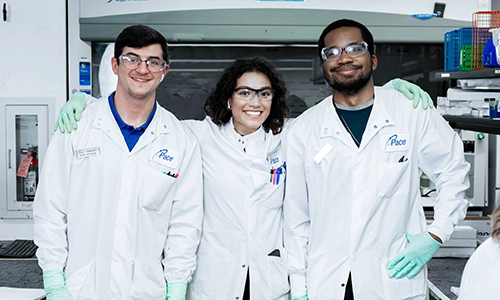Pace® Legionella Testing Services
- The Pace® Legionella testing services team is led by Janet E. Stout, PhD. Dr. Stout is recognized worldwide for her 30+ years of pioneering research in Legionella.
- In addition to being CDC Elite, many of the Pace® labs are AIHA accredited.
- We offer numerous test methods, including Legionella ISO culture, Legionella CDC culture, Legionella qPCR, and Legiolert.
- Pace® is an independent provider of Legionella testing and analysis services. There is no need to worry about biased or incomplete results.
- Twelve Legionella lab locations and mistake-proof shipping kits make it easy to get your samples to the lab safely and securely.
- Our online store makes it simple to make sure you always have the right testing supplies on hand.
- Pace® Legionella Emergency Response Services can manage all aspects of a Legionella outbreak.
Call: 412-281-5335
Reasons To Test For Legionella
Legionella bacteria can pose significant health risks, especially in environments where the bacteria can grow and spread, such as in large plumbing systems and cooling towers. Exposure to Legionella bacteria can result in Legionnaires’ disease, a severe form of pneumonia, or the less severe flu-like Pontiac fever. These illnesses can be fatal, particularly in people with compromised immune systems. Legionella testing can help organizations achieve several important goals.

Many organizations, such as those in the healthcare industry, are required to implement water management policies and procedures to reduce the risk of Legionella and other opportunistic pathogens. Testing is not always required but can play an important role in validating compliance.
Even if not required by law to test for Legionella, baseline testing can help validate the water safety management practices for organizations such as hotels and recreational facilities.
An outbreak of Legionnaires' disease traced back to an organization's facilities could significantly damage its reputation, potentially resulting in loss of business and other liabilities. Routine testing can help limit the risk of an outbreak. If an outbreak does occur, testing can help identify the source.
Pace® Legionella Water Testing Methods
Pace® Legionella Outbreak Response Services
- Outbreak Response Management
- Coordinate Emergency Disinfection
- Onsite Sampling and Risk Assessment
- Case Investigation Laboratory Services
- Laboratory Results Interpretation
- Liaison with Health Department
- Staff and Townhall Meetings
- Communication Strategies; Media And Public Relations
- Recommendations or Ongoing Disinfection
WHICH LEGIONELLA TEST SHOULD I USE?
Suitable for | TAT* | Advantages | Disadvantages | |
|---|---|---|---|---|
Legionella ISO Culture | 7 days** |
Longer TAT required than all other methods. (Can be paired with qPCR to begin initial outbreak forensics.) | ||
Legionella CDC Culture | 7 days** | Longer TAT required than Legionella qPCR. (Can be paired with qPCR to begin initial outbreak forensics.) | ||
Legionella qPCR | 1-2 days | |||
Legiolert | Baseline testing and water management validation | 7 days |
* Turnaround time. All TATs quoted are industry standard. Some scenarios may allow for faster turnaround. Talk with your Pace® representative if faster results are needed.
** Regulatory requirements in some states, such as New York and Connecticut, may extend TAT times. Talk with your Pace® representative for details.
Legionella Water Safety And Management Services
- Water Safety and Management Plans
- Water Infection Control Risk Assessment (WICRA)
- Environmental Risk Assessments
- ASHRAE 188 and State Regulatory Compliance
- Water Safety and Management Plan And Policy Audits
- Onsite Legionella Sampling And Sampling Plan Assistance
- Water Safety and Management Plan Implementation Support, Including Program Oversight, Onsite Quarterly Legionella Sampling, Annual Audits, and Plan Updates
- Outbreak Response Management
Legionella FAQs
Legionella was first identified following an outbreak in 1976 during an American Legion convention in Philadelphia. While the disease known as Legionnaire’s disease has been widely studied, the general public is often underinformed about the bacteria that causes it.
Legionella bacteria are found naturally in freshwater environments, such as lakes and streams, and prefer warmer water to cool. The bacteria can become a health concern when they grow and spread in artificial water systems, such as plumbing, storage tanks, cooling towers, decorative fountains, hot tubs, and manufacturing equipment. Transmission of Legionella is not passed from person to person. Rather, it is usually contracted by the inhalation of droplets in mist or vapor containing the bacteria.
Legionella testing in water systems is a best practice for protecting public health and mitigating organizational risk. The Centers for Medicaid and Medicare Services (CMS) requires Medicare and Medicare/Medicaid certified healthcare facilities to implement water management policies and procedures to reduce the risk of Legionella and other opportunistic pathogens in building water systems.
In 2022, new standards approved by the Joint Commission and designed to address Legionella and other waterborne pathogens also went into effect for all accredited and certified organizations, including hospitals, critical access hospitals, and nursing care centers. Some states may have their own requirements. For example, New York state requires all general hospitals and residential healthcare facilities to monitor and control Legionella as well.
For other types of organizations, the Centers for Disease Control and Prevention (CDC) provides guidelines for preventing Legionnaires' disease on its website. Additionally, the Occupational Safety and Health Administration (OSHA) has standards that may apply to workplaces with potential Legionella contamination, including Personal Protective Equipment (PPE) and respiratory protection. Once again, states may also set regulations for other industries. New York, for instance, requires cooling towers to be tested.
